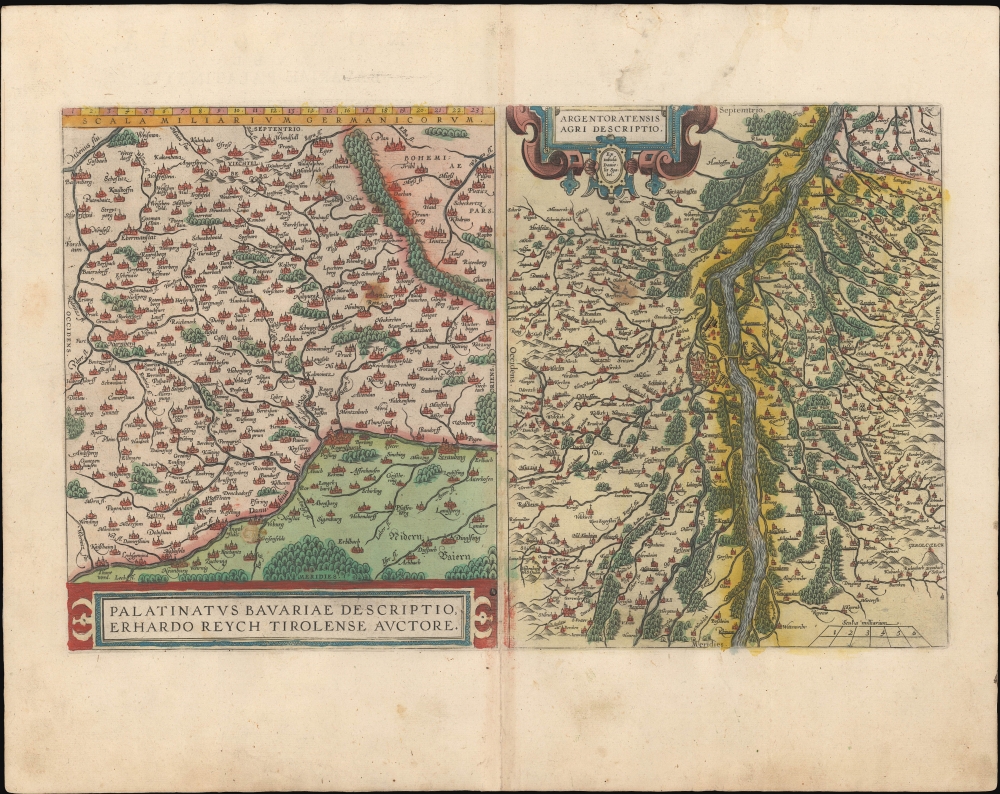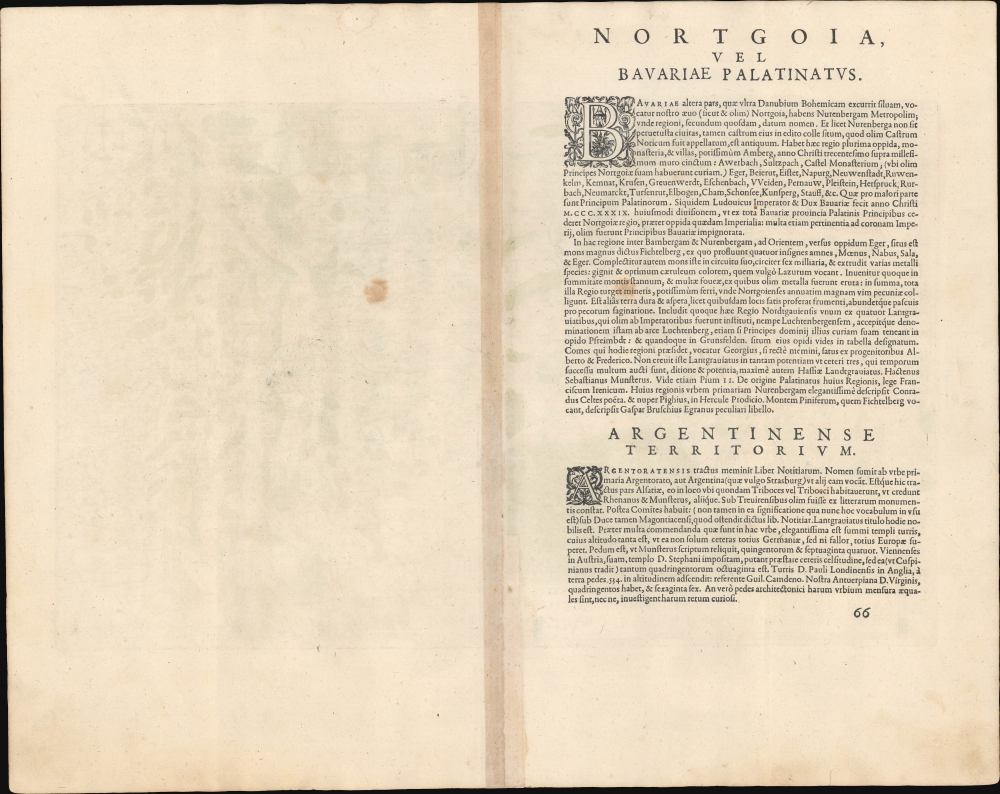1595 Ortelius Map of Bavaria, Alsace
BavariaeArgentor-ortelius-1595
Title
1595 (undated) 14 x 20 in (35.56 x 50.8 cm)
Description
A Closer Look
Both maps are oriented towards the north, label towns and cities, forests, and waterways, and include a scale and title cartouche. The map at left is divided by the Upper Palatine Forest at top-right and the Danube River, running across the bottom. Nurnberg (Nuremberg) is prominent at left, while Regensburg and Straubing stand out along the Danube. Not long after this map was published, this region was devastated as an early battlefield of the Thirty Years' War (1618 - 1648). As stated in the title, this map is based on work of 'Erhard Reych from Tirol;' Erhart Reich was a stonemason and builder who produced a map of the Upper Palatine in 1540.The map at right takes in a portion of the Rhine between Bavaria and Alsace. Stylistically, it differs from the map at left primarily in its illustration of hills, on either bank of the Rhine. Moreover, some forests are labeled and the names of certain settlements are underlined. Near center is Strasbourg, an important city in the late Medieval and early modern eras, home to Johannes Guttenberg, John Calvin, and other key figures of the times. As explained in a brief note below the title, it is based on Daniel Specklin's 1576 three-sheet map of the Elzas (Alsace) and prominently features the Rhine.
Publication History and Census
The map of the Upper Palatine appeared in the first edition of the Theatrum Orbis Terrarum in 1570 on a divided sheet with a map of Württemberg instead of Alsace and with the title and scale flipped at top and bottom. The present configuration with the map of Alsace first appeared in 1584. While the book's first edition was released in 1570, Ortelius continually improved the work - both by adding new maps, and by refining the production of the book. Maps appearing in editions of the Theatrum in the 1580s and 1590s generally display, as here, a finer quality of color than those in the earlier issues of the work.The present example conforms typographically to the 1595 Latin edition of the Theatrum (1595L66), of which 500 copies were printed. This map is well represented in institutional collections and appears on the market from time to time.
Cartographer
Abraham Ortelius (April 14, 1527 - June 28, 1598) also known as Ortels, was a cartographer, geographer, and cosmographer of Brabant, active in Antwerp. He was the creator of the first modern atlas, Theatrum Orbis Terrarum and is a seminal figure in the history of cartography. Along with Gerard Mercator and Gemma Frisius, he was a founder of the Netherlandish school of cartography. His connections with Spain - culminating in his 1575 appointment as Royal Cartographer to King Phillip II of Spain - gave him unmatched access to Spanish geographical knowledge during a crucial period of the Age of Discovery. Ortelius was born in 1527 in Antwerp. In 1547 he entered the Antwerp Guild of Saint Luke as an illuminator of maps. He began trading in books, prints, and maps, traveling regularly to the Frankfurt book and print fair, where in 1554 he met Mercator. He accompanied Mercator on journeys throughout France in 1560 and it was at this time, under Mercator's influence, that he appears to have chosen his career as a scientific geographer. His first published geographic work appeared in 1564, an eight-sheet cordiform world map. A handful of other maps preceded the 1570 publication of the first edition of the Theatrum Orbis Terrarum, which would prove to be his life work. Appearing with but 53 maps in its first edition, Ortelius' work expanded with new maps added regularly. By 1592, it had 134 maps. Many of Ortelius' maps remained the standard for nearly a century. He traveled extensively, but his genius was as a compiler, locating the best informed maps on which to base his own. His contacts throughout Europe and extending even (via the Portuguese) to the Far East were formidable. Moreover, many of his maps were based on his own scholarship, particularly his historical works. His theories of geography were particularly ahead of his time with respect to the notion of continental drift, the possibility of which he mused on as early as 1596, and which would be proven correct centuries later.
In a sense his greatest achievement was his successful navigation of the religious and political violence endemic to his city throughout his adult life: The Dutch Revolt, or Eighty Years' War (1568 - 1648), fully embroiled Antwerp. Although outwardly and officially recognized as Catholic (Arias Montanus vouched for Ortelius' Catholic orthodoxy prior to his appointment as Royal Geographer), Ortelius was able to separate himself from the religious furor which characterized the war in the low countries. Ortelius showed a glimpse of himself in a letter to a friend, regarding humanist Justus Lipsius: 'I do not know whether he is an adherent of the Pope or a Calvinist, but if he has ears to hear, he will neither be one nor the other, for sins are committed on both sides'. Ortelius' own explorations of Biblical history in his maps, and the Christogram contained in his own motto, suggest him to be a religious man, but his abjuration of political religious authorities mark him as an individualist. His tombstone at St Michael's Præmonstratensian Abbey in Antwerp bears the inscription, Quietis cultor sine lite, uxore, prole. ('served quietly, without accusation, wife, and offspring.') More by this mapmaker...




